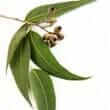Background
- Guggul (gum guggul) is the common name for the mukul myrrh tree (Commiphora mukul). Guggul is also the name of the sap-like product produced by the tree. Guggulipid, which is extracted from guggul, contains guggulsterones, which may have health benefits for humans.
- Guggul has been used medicinally, primarily in India, since at least 600 BC. In Ayurveda, or traditional Indian medicine, guggul has been used to treat a variety of conditions, including cancer, obesity, liver disorders, urinary complaints, intestinal worms, and sinus conditions. Guggul may haves possible effects on levels of cholesterol and other fats; however caution may be warranted when using in patients with advanced diabetic renal disease, or hypertension. However, no existing research supports the use of guggul to treat any condition in humans.
References
Natural Standard developed the above evidence-based information based on a thorough systematic review of the available scientific articles. For comprehensive information about alternative and complementary therapies on the professional level, go to . Selected references are listed below.
- An MJ, Cheon JH, Kim SW, et al. Guggulsterone induces apoptosis in colon cancer cells and inhibits tumor growth in murine colorectal cancer xenografts. Cancer Lett 2009;279(1):93-100.
View Abstract - Cornick CL, Strongitharm BH, Sassano G, et al. Identification of a novel agonist of peroxisome proliferator-activated receptors alpha and gamma that may contribute to the anti-diabetic activity of guggulipid in Lep(ob)/Lep(ob) mice. J Nutr Biochem 2009;20(10):806-15.
View Abstract - Gebhard C, Stämpfli SF, Gebhard CE, et al. Guggulsterone, an anti-inflammatory phytosterol, inhibits tissue factor and arterial thrombosis. Basic Res Cardiol 2009;104(3):285-94.
View Abstract - Kalariya NM, Shoeb M, Reddy AB, et al. Prevention of endotoxin-induced uveitis in rats by plant sterol guggulsterone. Invest Ophthalmol Vis Sci 2010;51(10):5105-13.
View Abstract - Kapoor S. Guggulsterone: a potent farnesoid X receptor antagonist and its rapidly evolving role as a systemic anticarcinogenic agent. Hepatology 2008;48(6):2090-1.
View Abstract - Kim ES, Hong SY, Lee HK, et al. Guggulsterone inhibits angiogenesis by blocking STAT3 and VEGF expression in colon cancer cells. Oncol Rep 2008;20(6):1321-7.
View Abstract - Kim JM, Kang HW, Cha MY, et al. Novel guggulsterone derivative GG-52 inhibits NF-kappaB signaling in intestinal epithelial cells and attenuates acute murine colitis. Lab Invest 2010;90(7):1004-15.
View Abstract - Leeman-Neill RJ, Wheeler SE, Singh SV, et al. Guggulsterone enhances head and neck cancer therapies via inhibition of signal transducer and activator of transcription-3. Carcinogenesis 2009;30(11):1848-56.
View Abstract - Nohr LA, Rasmussen LB, Straand J. Resin from the mukul myrrh tree, guggul, can it be used for treating hypercholesterolemia? A randomized, controlled study. Complement Ther Med 2009;17(1):16-22.
View Abstract - Shishodia S, Harikumar KB, Dass S, et al. The guggul for chronic diseases: ancient medicine, modern targets. Anticancer Res 2008;28(6A):3647-64.
View Abstract - Xiao D, Singh SV. z-Guggulsterone, a constituent of Ayurvedic medicinal plant Commiphora mukul, inhibits angiogenesis in vitro and in vivo. Mol Cancer Ther 2008;7(1):171-80.
View Abstract - Xu HB, Li L, Liu GQ. Reversal of P-glycoprotein-mediated multidrug resistance by guggulsterone in doxorubicin-resistant human myelogenous leukemia (K562/DOX) cells. Pharmazie 2009;64(10):660-5.
View Abstract - Yamada T, Osawa S, Hamaya Y, et al. Guggulsterone suppresses bile acid-induced and constitutive caudal-related homeobox 2 expression in gut-derived adenocarcinoma cells. Anticancer Res 2010;30(6):1953-60.
View Abstract - Youn HS, Ahn SI, Lee BY. Guggulsterone suppresses the activation of transcription factor IRF3 induced by TLR3 or TLR4 agonists. Int Immunopharmacol 2009;9(1):108-12.
View Abstract - Yu BZ, Kaimal R, Bai S, et al. Effect of guggulsterone and cembranoids of Commiphora mukul on pancreatic phospholipase A(2): role in hypocholesterolemia. J Nat Prod 2009;72(1):24-8.
View Abstract







